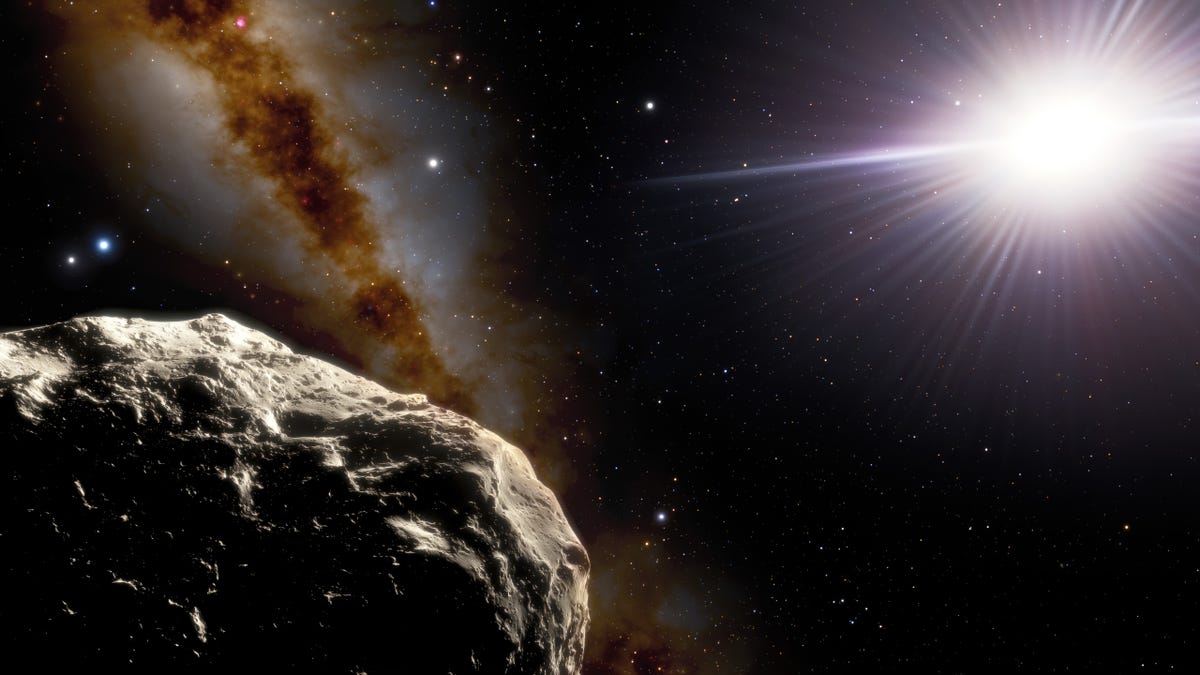How to Watch Earth's Extremely Close Encounter With an Asteroid Today
NASA says it poses no threat, but will make the top five list of near misses.

In this illustration, the asteroid is shown in the foreground in the lower left. The two bright points above it on the far left are Earth (right) and the moon (left).
Skywatchers are buzzing in anticipation of a small asteroid expected to give Earth a close shave Thursday, traveling much closer to us than the ring of large telecommunications satellites circling overhead.
NASA says Asteroid 2023 BU will fly over the southern tip of South America at 4:27 p.m. PT at an altitude of only 2,200 miles (3,600 kilometers) above the surface. That's far enough that it poses no threat of impact, and even if it did, the bus-size rock would likely burn up completely in our atmosphere.
Still, the cosmic traveler is notable because it'll be the fourth-closest pass by a near-Earth object that's ever been observed. And perhaps more exciting, it was discovered several days before its close pass, giving the entire world the opportunity to witness the flyby.
Roughly once a month or so on average, astronomers spot an asteroid making a close pass by Earth within that ring of geosynchronous satellites 22,236 miles (35,786 kilometers) above the planet. Typically, however, the discovery is made mere hours before or even after the moment of closest approach.
The ground track of #asteroid 2023 BU.
— Tony Dunn (@tony873004) January 25, 2023
On the night of the 26th, it will be:
mag 16 for N. America
mag 15 for East Asia.
mag 14 Northern India.
mag 13 for the Middle East
mag 12 for Africa
mag 11 for South America pic.twitter.com/xjZDh7ZcH0
The amateur astronomer who first noticed 2023 BU on Saturday is a familiar name in astronomy circles: Gennadiy Borisov, who also discovered an interstellar comet that bears his name from his observatory in Crimea.
After Borisov's find, a few others made additional observations to refine the asteroid's orbit around the sun and project how close its path would be to Earth. NASA's Scout impact hazard assessment system was quick to determine that the space rock poses no real threat.
Here it is asteroid 2023 BU, safely coming extremely close to us in a couple of days (10.000km from Earth0s center, 1/4 of the distance of geostationary sats). We capture it minutes ago and will show it live to you at the flyby time!
— Virtual Telescope (@VirtualTelescop) January 24, 2023
👉🔭☄️ more: https://t.co/S1QX9cCC2C pic.twitter.com/rL2ubGJ6R4
"Scout quickly ruled out 2023 BU as an impactor, but despite the very few observations, it was nonetheless able to predict that the asteroid would make an extraordinarily close approach with Earth," said Davide Farnocchia, a navigation engineer at NASA's Jet Propulsion Laboratory who developed Scout. "In fact, this is one of the closest approaches by a known near-Earth object ever recorded."
It's possible to spot the asteroid as it flies by with a decent telescope and a little expertise, but for most of us the best way to see the close encounter is via a livestream like the one from Rome-based Virtual Telescope Project. You can watch below. The feed was scheduled to go live at 11:15 a.m. PT, but that's been delayed because of cloud cover.

